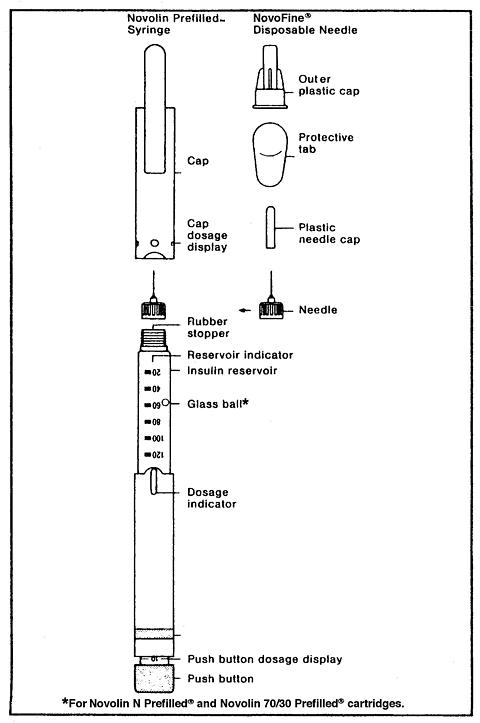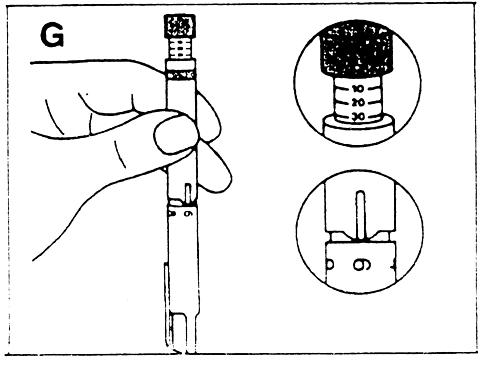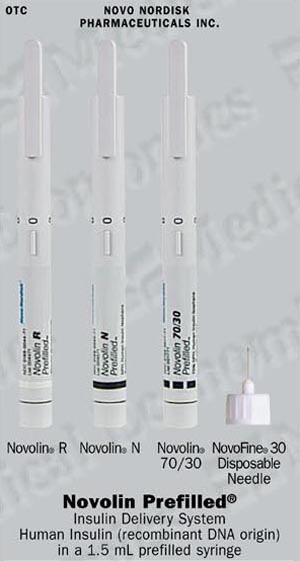 |
Please read both sides of this leaflet carefully before using this product.
Novolin Prefilled® syringe is for single person use only. See Important Notes section.
SPECIAL CARE SHOULD BE TAKEN WHEN THE TRANSFER IS FROM A STANDARD BEEF OR MIXED SPECIES INSULIN TO A PURIFIED PORK OR HUMAN INSULIN. IF A DOSAGE ADJUSTMENT IS NEEDED, IT WILL USUALLY BECOME APPARENT EITHER IN THE FIRST FEW DAYS OR OVER A PERIOD OF SEVERAL WEEKS, ANY CHANGE IN TREATMENT SHOULD BE CAREFULLY MONITORED.
PLEASE READ THE SECTIONS "INSULIN REACTION AND SHOCK" AND "DIABETIC KETOACIDOSIS AND COMA" FOR SYMPTOMS OF HYPOGLYCEMIA (LOW BLOOD GLUCOSE) AND HYPERGLYCEMIA (HIGH BLOOD GLUCOSE).
Your physician has explained that you have diabetes and that your treatment involves injections of insulin or insulin therapy combined with an oral antidiabetic medicine. Insulin is normally produced by the pancreas, a gland that lies behind the stomach. Without insulin, glucose (a simple sugar made from digested food) is trapped in the bloodstream and cannot enter the cells of the body. Some patients who don't make enough of their own insulin, or who cannot properly use the insulin they do make, must take insulin by injection in order to control their blood glucose levels.
Each case of diabetes is different and requires direct and continued medical supervision. Your physician has told you the type, strength and amount of insulin you should use and the time(s) at which you should inject it, and has also discussed with you a diet and exercise schedule. You should contact your physician if you experience any difficulties or if you have questions.
Standard and purified animal insulin as well as human insulin are available. Standard and purified insulin differ in their degree of purification and content of noninsulin material. Standard and purified insulin also vary in species source: they may be of beef, pork, or mixed beef and pork origin. Human insulin is identical in structure to the insulin produced by the human pancreas, and thus differs from animals insulin. Insulin Products vary in time of action; see PRODUCT DESCRIPTION for additional information.
Your physician has prescribed the insulin that is right for you; be sure you have purchased the correct insulin and check it carefully before you use it.
A package contains five (5) Novolin Prefilled® insulin syringes.
This human insulin (recombinant DNA origin) is structurally identical to the insulin produced by the human pancreas. This human insulin is produced by recombinant DNA technology utilizing Saccharomyces cerevisiae (bakers' yeast) as the production organism.
Novolin 70/30 Prefilled® contains Novolin® 70/30, a mixture of 70% NPH, Human Insulin Isophane Suspension (recombinant DNA origin) and 30% Regular, Human Insulin Injection (recombinant DNA origin) USP. The concentration of this product is 100 units of insulin per milliliter. It is a cloudy or milky suspension of human insulin with protamine and zinc. The insulin substance (the cloudy material) settles to the bottom of the insulin reservoir, therefore, the syringe must be rotated up and down so that the contents are uniformly mixed before a dose is given. Novolin® 70/30 has an intermediate duration of action. The effect of Novolin® 70/30 begins approximately 1 / 2 hours after injection. The effect is maximal between 2 and approximately 12 hours. The full duration of action may last up to 24 hours after injection.
The time course of action of any insulin may vary considerably in different individuals, or at different times in the same individual. Because of the variation, the time periods listed here should be considered as general guidelines only.
Novolin N Prefilled® contains NPH, Human Insulin Isophane Suspension (recombinant DNA origin). The concentration of this product is 100 units of insulin per milliliter. It is a cloudy or milky suspension of human insulin with protamine and zinc. The insulin substance (the cloudy material) settles to the bottom of the insulin reservoir, therefore, the syringe must be rotated up and down so that the contents are uniformly mixed before a dose is given. Novolin® N has an intermediate duration of action. The effect of Novolin® N begins approximately 1 1 / 2 hours after injection. The effect is maximal between 4 and approximately 12 hours. The full duration of action may last up to 24 hours after injection.
Novolin R Prefilled® contains Regular, Human Insulin Injection (recombinant DNA origin) USP. The concentration of this product is 100 units of insulin per milliliter. It is a clear, colorless solution which has a short duration of action. The effect of Novolin® R begins approximately 1 / 2 hour after injection. The effect is maximal between 2 1 / 2 and 5 hours and ends approximately 8 hours after injection.
Novolin Prefilled® insulin syringes should be stored in a cold place, preferably in a refrigerator, but not in the freezing compartment. Do no let it freeze. Keep Novolin Prefilled® in the carton so that they will stay clean and protected from light. Novolin 70/30 Prefilled® and Novolin N Prefilled® can be kept unrefrigerated for one (1) week.
Novolin R Prefilled® can be kept unrefrigerated for (1) month. Unrefrigerated syringes must be used within this time period or discarded. Be sure to protect syringes from sunlight and extreme heat or cold.
Never use any Novolin R Prefilled® if the insulin becomes viscous (thickend or cloudy); use it only if it is clear and colorless. Never use any Novolin 70/30 Prefilled® or Novolin N Prefilled® if the precipitate (the white deposit) has become lumpy or granular in appearance or has formed a deposit of solid particles on the wall of the insulin reservoir. This insulin should not be used if the liquid in the insulin reservoir remains clear after it has been mixed.
IMPORTANT
Failure to comply with the following antiseptic measures may lead to infections at the injection site.
Never place a single-use needle on your insulin delivery device until you are ready to give an injection, and remove it immediately after each injection. If the needle is not removed, some liquid may be expelled from the syringe causing a change in the insulin concentration (strength).
For Novolin N Prefilled® & Novolin 70/30 Prefilled®, the cloudy material in an insulin suspension will settle to the bottom of the insulin reservoir, so the contents must be mixed before injection. These syringes contain a glass ball to aid mixing.
Rotate the syringe up and down so that the contents are uniformly mixed before the dose is given.
Follow the directions for use of this syringe on the reverse side of this insert.
Insulin prefilled in cartridges may contain a small amount of air. To prevent an injection of air and make certain insulin is delivered an air shot must be done before each injection. Directions for performing an air shot are provided in your insulin delivery device instruction manual.
For additional information see GIVING THE INJECTION on the reverse side of this insert.
It is particularly important to maintain good control of your diabetes during pregnancy and special attention must be paid to your diet, exercise and insulin regimens. If you are pregnant or nursing a baby, consult your physician or nurse educator.
Insulin reaction (hypoglycemia) occurs when the blood glucose falls very low. This can happen if you take too much insulin, miss or delay a meal, exercise more than usual or work too hard without eating, or become ill (especially with vomiting or fever). Hypoglycemia can also happen if you combine insulin therapy and other medications that lower blood glucose, such as oral antidiabetic agents or other prescription and over-the-counter drugs. The first symptoms of an insulin reaction usually come on suddenly. They may include a cold sweat, fatigue, nervousness or shakiness, rapid heartbeat, or nausea. Personality change or confusion may also occur. If you drink or eat something right away (a glass of milk or orange juice, or several sugar candies), you can often stop the progression of symptoms. If symptoms persist, call your physician-an insulin reaction can lead to unconsciousness. If a reaction results in loss of consciousness, emergency medical care should be obtained immediately. If you have had repeated reactions or if an insulin reaction has led to a loss of consciousness, contact your physician. Severe hypoglycemia can result in temporary or permanent impairment of brain function and death.
DIABETIC KETOACIDOSIS AND COMA
Diabetic ketoacidosis may develop if your body has too little insulin. The most common causes are acute illness or infection or failure to take enough insulin by injection. If you are ill you should check your urine for ketones. The symptoms of diabetic ketoacidosis usually come on gradually, over a period of hours or days, and include a drowsy feeling, flushed face, thirst and loss of appetite. Notify your physician right away if the urine test is positive for ketones (acetone) or if you have any of these symptoms. Fast, heavy breathing and rapid pulse are more severe symptoms and you should have medical attention right away. Severe sustained hyperglycemia may result in diabetic coma and death.
A few people with diabetes develop red, swollen and itchy skin where the insulin has been injected. This is called a "local reaction" and it may occur if the injection is not properly made, if the skin is sensitive to the cleaning solution or if you are allergic to the insulin being used. If you have a local reaction, tell your physician.
Generalized insulin allergy occurs rarely, but when it does it may cause a serious reaction, including skin rash over the body, shortness of breath, fast pulse, sweating, and a drop in blood pressure. If any of these symptoms develop, you should seek emergency medical care.
If severe reactions to insulin have occurred (i.e. generalized rash, swelling or breathing difficulties) you should be skin-tested with each new insulin preparation before it is used.
Helpful information for people with diabetes is published by American Diabetes Association, 1660 Duke Street, Alexandria, VA 22314.
For information contact:
Novo Nordisk Pharmaceuticals, Inc.
100 College Road West
Princeton, NJ 08540
1-800-727-6500
Manufactured by
Novo Nordisk A/S
DK-2880 Bagsvaerd, Denmark
License under U.S. Patent No. 5,462,535 and Des. 347,894 restricted to use with Novo Nordisk insulin delivery devices and Novo Nordisk pen needles.
Novo Nordisk®, Novolin®, PenFill®, NovoPen®, NovolinPen®, NovoFine® and Lente® are trademarks owned by Novo Nordisk A/S
Date of Issue: Dec 1998
Novolin 70/30 Prefilled® Syringe, U-100, 100 units/ml, 1.5 ml, (List No. 001771) (5's)
Novolin N Prefilled® Syringe, U-100, 100 units/ml, 1.5 ml, (List No. 004571) (5's)
Novolin R Prefilled® Syringe, U-100, 100 units/ml, 1.5 ml, (List No. 004471) (5's)
This is a disposable dial-a-dose insulin delivery system able to deliver 2-58 units in increments of 2 units. Novolin Prefilled® syringe is designed for use with NovoFine® single use needle or other products specifically recommended by Novo Nordisk. Novolin Prefilled® syringe is not recommended for the blind or visually impaired without the assistance of a sighted individual trained in the proper use of this product.
 |
1.Preparing the Syringe
Pull off the cap.
 |
A. Turn the syringe up and down between a and b so the glass ball is moved from one end of the insulin reservoir to the other. Do this at least 10 times, until the liquid appears uniformly white and cloudy. Wipe rubber stopper with an alcohol swab. This step is not necessary with Novolin R Prefilled®.
 |
B. Remove the protective tab from disposable needle and screw the needle onto the syringe. Never place a disposable needle on your syringe until you are ready to give an injection. Remove the needle immediately after use. If the needle is not removed, some liquid may be expelled from the syringe causing a change in insulin concentration (strength).
Small amounts of air may collect in the needle and insulin reservoir during normal use.
To avoid the injection of air and ensure proper dosing, hold the syringe with the needle upwards and tap the syringe gently with your finger so any air bubbles collect in the top of the reservoir. Remove both the plastic outer cap and the needle cap.
 |
C. Holding the syringe with the needle pointing upwards, slowly turn the insulin reservoir clockwise (in the direction of the arrow, fig. C) to the first notch where resistance is felt ( 1 / 5 of a full rotation).
D. Still with the needle pointing upwards, press the push button as far as it will go and see if a drop of insulin appears at the needle tip (Fig. D).
Before the first use of Novolin Prefilled® you may need to perform up to 6 air shots to get a droplet of insulin at the needle tip. If you need to make more than 6 air shots do not use and return the product to Novo Nordisk.
If not, repeat the procedure until insulin appears. A small air bubble may remain but it will not be injected because the operating mechanism prevents the reservoir from being completely emptied.
 |
E. Replace the cap, so 0 is opposite the dosage indicator.
 |
F. Hold the syringe horizontally and turn the cap in the direction of the arrow to set the required dose. Do not put your hand over the push button when dialing the dose. If the button is not allowed to rise freely, insulin will be pushed out of the needle. The dosage display on the cap shows 0, 2, 4, 6 and 8 units.
 |
G. As the cap is turned, the push button rises. The dosage display below the push button shows 10, 20, 30, 40 and 50 units. Every time you fully turn the cap, 10 units will be set.
To check the dose set, add the figure on the cap opposite the dosage indicator to the highest number showing on the push button display.
If you have set a wrong dose, simply turn the cap forwards or backwards until the right number of units has been set.
58 units is the maximum dose. If you attempt to set a higher dose, insulin will be expelled from the needle and the dose will be wrong. If you set more than 58 units, turn the cap back as far as you can until resistance is felt and the push button is fully depressed. If the dosage indicator is not lined up with 0 when resistance is felt, remove the cap and replace it with 0 opposite the dosage indicator. Now start again, remembering that 58 units is the maximum dose. After the dose is set, remove the cap.
Use the injection technique recommended by your doctor. Check that you have set the proper dose and depress the push button as far as it will go. When depressing the push button you may hear a clicking sound. Do not rely on this clicking sound as a means of determining or confirming your dose. After making the injection, replace the plastic outer cap. Unscrew the needle and discard appropriately. Replace the cap with 0 opposite the dosing indicator.
For additional information see GIVING THE INJECTION on the reverse side of this insert.
Always check that the push button is fully depressed before using the syringe again. If not, turn the cap until the push button is completely down. Then proceed as stated under steps 1-3.
The numbers on the insulin reservoir can be used to estimate the amount of insulin left in the syringe. These numbers are not used for measuring the insulin dose.
You cannot set a dose greater then the number of units remaining in the reservoir.
If you are using Novolin N Prefilled® or Novolin 70/30 Prefilled® there must be at least 12 units left in the reservoir to give the glass ball space to move when mixing the insulin. If your dose is less than 12 units -- and the reservoir is nearly empty -- first dial up to 12 (to check that 12 units are left) and then set the desired dose. If 12 cannot be dialed, change to a new syringe. Discard the used syringe carefully, without the needle attached.
If you need to perform more than 6 air shots before the first use of Novolin Prefilled® to get a droplet of insulin at the needle tip, do not use.
For information contact:
Novo Nordisk Pharmaceuticals, Inc.
100 College Road West
Princeton, NJ 08540
1-800-727-6500
Manufactured by
Novo Nordisk A/S
DK-2880 Bagsvaerd, Denmark
License under U.S. Patent No. 5,462,535 and Des. 347,894 restricted to use with Novo Nordisk insulin delivery devices and Novo Nordisk pen needles.
Novo Nordisk®, Novolin®, PenFill®, NovoPen®, NovolinPen®, NovoFine® and Lente® are trademarks owned by Novo Nordisk A/S
Date of issue: December 1998
 |